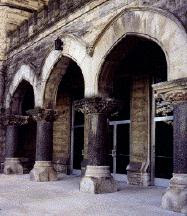so very long he had no notion
how long it took to notify
his tail of his emotion
and thus it was that while his eyes
were filled with woe and sadness
his little tail kept wagging on
due to previous gladness
-anonymous

A BLOG FOR FRIENDS OF THE MATHEMATICS AND COMPUTER SCIENCE DEPARTMENT AT EASTERN ILLINOIS UNIVERSITY.
and thus it was that while his eyes
were filled with woe and sadness
his little tail kept wagging on
due to previous gladness
-anonymous
Ok. I have been very lazy about the blog. Let's start with
News from Old Main
The Department welcomes two new faculty members: Bogdan Petrenko formerly of University of Illinois and Alejandra Alvarado recently of Purdue University.
Jonelle and Leo Comerford visited the Department this fall after having moved to Colorado.
Six students and two faculty members from the Department of Mathematics and Computer Science attended the Consortium for Computing Sciences in Colleges' Midwest Conference this September in Findlay, Ohio. Professors Andrew Mertz and Nancy Van Cleave gave a presentation on an assignment for Computer Science 1 called “Bubble Fountain with Wandering Black Hole: Designing a Particle Class.”
Students competed in a programing competition where one of the teams consisting of Murat Aksoy, Joel Blome and Brian Bourne came in second place among all 26 teams at the competition. Another team of Jason Banahan, Bradley Chatman and Ross Mattingly came in 13th place.
Bill Slough and Andrew Mertz attended a TeX conference at the University of Tokyo in October.
Keith Wolcott has retired from teaching and will spend some of his spare time preparing for a long distance bike race.
This is the earliest start in recent memory.
The Department is seeking to fill some assistant professor positions and so we have a considerable presence at the San Diego meeting this week.
Bill Slough is back from his sabbatical which included sitting in on one of those on-line computer courses with an elephantine student list and some fabulous extracurricular bread making.
Last month saw the only 12/12/12 of the century. Indeed our last post had the distinction of coming to be on that great day even though we passed silently over the fact in that post.
And this year will see the only 11/12/13 of the century. No cause for alarm tho, since the following year will see a 10/12/14. Well ... I guess the list goes on and on.
THE `DUPLICITY’ OF MATHEMATICS IN THE REAL, IMPERFECT WORLD
Below is a sample of the abstract:
A new look at old, fundamental problems in Physics, Chemistry, Biochemistry and Biology will be presented from the point of view of modern Mathematics and Logics focused on complexity, asymmetry and symmetry concepts applied to fundamental problems in Life Sciences and Quantum Physics. The presentation is divided into two unequal parts consistent with the idea of the `duplicity’ of Mathematics when applied to nonlinear, highly complex problems in the real World. The first, concise, part introduces a few, logical and mathematical concepts that are essential to understanding both dynamic complexity and partially disordered structures (quasi-‐crystals, liquid crystals and paracrystals) in physical, chemical and biological systems—especially highly-‐evolved organisms such as Homo-sapiens.
The second part will present several fundamental aspects of modern biology approached from the point of view of complex systems and mathematical modeling.
In 1950, Mark Graev gave a construction of two-sided invariant metrics on free groups over metrics spaces. These metrics were later used in descriptive set theory to produce exotic Polish groups. We will describe a similar construction of metrics on free products (possibly with amalgamation) of groups with two-sided invariant metrics and discuss some applications. I will try to reduce preliminaries to minimum.
The department welcomes a new faculty member, Ravi Somayajulu, for the fall of 2012.
The College of Science will have a new Dean, Harold Ornes. Dean Ornes will start work in the college this upcoming summer. Dean Ornes is an aquatic botanist.
Professor Andrew Mertz gave a talk on Ipad/Ipod programming on February 24 and Professor Patrick Coulton and Professor Peter Andrews spoke on invisible objects on March 2nd.
The Department will host a Geometry/Topology Day on April 7th. Research mathematicians from across the mid-west will attend. See the department webpage link on the sidebar for more information.
The 55th annual Teaching of Mathematics Conference will be held on campus April 17, 2012. See Conference web page

